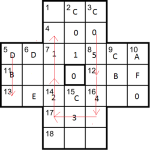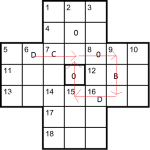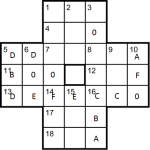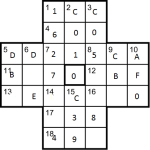Listener 4321: Solitaire II by Xanthippe — Full Solution Path
Posted by Jaguar on 12 Dec 2014
Ah, the numerical puzzles! My highlights of the year… or at least they used to be, before I discovered the joys of the cryptic side of Listeners. Still, I look forward to them. A fresh challenge, a chance to have a break from leafing through the battered copy of Chambers. And the inevitable detailed solution blog to follow.
Xanthippe’s challenge this week involves the game of Solitaire and hexadecimal numbers. I never could solve Solitaire myself when younger, so now at last I might be walked through the solution. Well, that’s nice! But first a grid fill with not all that much to go on. Except for the interesting point that the numbers 2 to 9 will occur exactly once each in the filled grid, so that will give us something that may help constrain entries.
A while later, I’d stumbled my way to a final grid, and was left with following the instructions for playing the game. One or two hiccups later and, at last, I was staring at three final words. “Beccafico”, apparently some bird or other, and then of course the final words have to be “Cod” and … “Dobo”? Hmm… or I could go the other way round that final loop and recover the words “Cob” and “Dodo”, both of which are also birds, apparently. Along with Solitaire, which is also a bird. So far as I can tell, there’s no link beyond all being birds, although some species of solitaire are extinct, along with the dodo of course.
So that’s the destination sorted, and now it’s time to figure out the journey.
* * * * * * * *
Solution Path
Obviously the starting point is understanding how to work with hexadecimal numbers. There are plenty of guides available. Still, I found it easier to interchange between normal numbers and hexadecimal ones, and excel is quite useful in this. Knowing that hex(100)=dec(256) and hex(FFE)=dec(4094), and then using Excel’s generous DEC2HEX function can generate all numbers in between. Of this list we’ll only need 24 numbers in the end so it’s a bit of overkill, but still, nice to be able to have the full list as you can then easily trial possibilities. And anyway, arithmetic is easier in decimal for most people, and certainly it’s easier for me. One day, perhaps, I’ll get around to understanding how arithmetic works in different bases. That would have made Radix’s numerical offering in base 24 from last year one heck of a lot easier, for example.
Anyway…
The obvious entry point is 10dn, which we are told is a multiple of 7, 10 and 64 (all in base 16), or 7, 16 and 100 in decimal numbers. The only number in the range given that fits is 2800, or AF0. We can also enter final-digit 0’s in 11ac and 4ac. On the other hand, 9dn doesn’t end in 0, but 16ac contains a repeated digit and at least one letter. 16ac is also less than E00 but greater than AF0, so it can only be BB0, CC0 or DD0 (or 2992, 3264, 3536 in decimal). Of these, only 3264 divides by 6, so 16ac is CC0. (Alternatively, B and D are odd numbers, but 9dn is even, hence again only CC0 fits.)
14ac is greater than E00, has no repeated digits and contains only letters, while 15dn is also greater than E00, so both start E or F. So 14ac is FEC or EFC. But 7dn is odd, so 14ac is FEC.
The four possible starting moves in the game involve jumping from the middle cells of 11ac, 2dn, 12ac, 15dn to the central cell, but most also involve the same-value cells. Out of these four clues, only 11ac has a repeated digit, so 11ac must be x00 for x=B, C. Indeed, since 5dn is made of only odd digits, 11ac can be only B00. 5dn meanwhile is bigger than 16ac, less than E00, contains only odd digits and has a repeated digit. This means that it can be only DBB or DBD, but the first is ruled out because 13ac is also bigger than 16ac, making 5dn DBD.
5ac contains a repeated digit, but 7ac evidently starts with a number (contains only 0-9), whereas 6dn starts with a letter (greater than 16ac). Hence 5ac=DDx for even x=2,4,6,8. 13ac had only letters, but is also greater than 5dn, while 6dn is even, making 13ac=DCF or DEF. But DCF=3535 is divisible by 7, a property 13ac doesn’t have according to the list. Hence 6dn is D0E and 13ac is DEF.
16dn is a multiple of 6, hence it is even, and contains only letters without having a repeated digit. Hence 16dn ends in A or E. 17ac is odd so ends in B, D or F, making 16ac CBA, CBE, CDA, CDE, CFA or CFE. The last four are ruled out by noting that 16dn is
less than 16ac, while CBE=3262 is not divisible by 6, so than 16dn is CBA.
Just over half-way through the grid-fill now. Note that so far there has been very little actual arithmetic. A couple of divisions by 6 or 7, and noting that A, C, E are even numbers and B, D, F are odd, but that’s about it.
To continue… notice that 1ac is small, and starts with a small number therefore, but that 2dn and 3dn must both begin with B or C. Since 1ac has a repeated digit it must be xBB or xCC. But then 1ac is not odd, so it is xCC. 2dn is also less than 3dn, which is only possible if its second digit is 0. 9dn is sandwiched between 16dn and 16ac so must start with C, and as it cannot be CCC (no entry has the same three digits) it must be CBC.
8ac is a multiple of 6, so that its digits sum to a multiple of 3. This turns out to be possible only for 2CA, 5CA and 8CA. But 3dn is odd, so 8ac is 5CA.
At this point there are nine cells left to fill, but as we need at least one 1, and exactly one each of 2,3,4,6,7,8,9, we have eight of the nine cells almost sorted up to permutation. This is part of what was meant by “paying attention to the removal instructions”.

After 9-6 have been removed, and showing the removal of the last 5 numbers. The D then jumps over the B to begin spelling out BECCAFICO.
7ac is less than 8ac while 5ac is even, hence 5ac becomes DD2 or DD4. But DD4 is divisible by 6, an option ruled out as 5ac was not listed as a multiple of 6, so it is DD2. 1ac therefore begins with 1 as it is less than 7dn and we can’t use another 2 in the grid. 18ac must begin with 4, as 14dn is even. 2dn is divisible by 7 and ends in 1 or 3. C03 isn’t divisible by 7, but C01 is. This means that there are two 1s (which was perhaps to be expected, as apparently in the final game the three words might use a 1, to be read as I), and the remaining empty cells are 3,6,7,8,9 in some order. Two out of 3, 7 and 9 will appear in 17ac (contains only odd digits),
and as 15dn is odd then in fact all three of the odd numbers are in the three empty cells at the bottom of the grid. Hence 4ac is 600 or 800 and 12ac is 6BF or 8BF, but 12ac is greater than 4ac so 4ac is 600 while 12ac is 8BF. 17ac is less than 12ac but greater than 8ac, so begins with 7. Therefore 15dn is E39 or E93. But E93 is divisible by seven! So 15dn is E39 and we have a completed final grid.
To play the game, following the instructions gives us little choice for the first few moves. The 0 must go first, then there’s only one way to remove an F; we need remove an E while making it possible to jump over a D next move.
Following the instructions leads to a workable first few moves. I’ll leave it to Dave Hennings, who might put together an animation of the game, to show how to play it, but I’ve included a few intermediate steps to the side.

Showing the final few moves. The D runs in a loop before being taken by the final 0, to give COB and DODO.
So that marks the first time I’ve completed a game of Solitaire, I think! A very neat exercise in logic, so thanks Xanthippe.
With only five puzzles to go in the year, I wonder what is left in store for us…


Alastair Cuthbertson said
You should try and get hold of a copy of The Ins and Outs of Peg Solitaire by John D Beasley published by OUP. It has loads of solutions!!